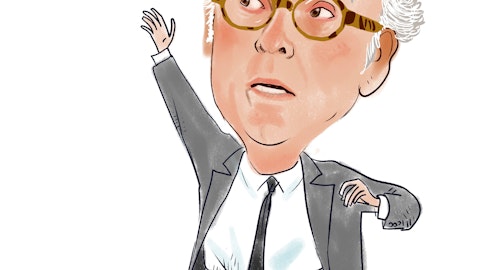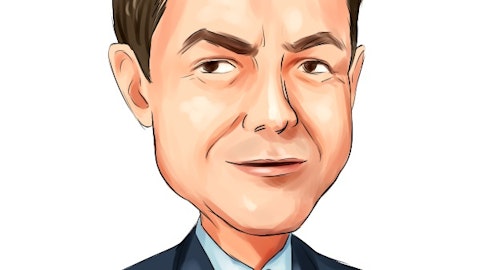Thomas Priore: That’s right because you’ll just see — you’ll see some more onboarding trends that would increase. And then like I said, we’re still early innings in just the rollout of the other segments of the embedded financial tools and their capabilities. So which is — look, just going back to your initial question about guidance, right? We want to get some adoption expectations and trends, which would give us better insight as to how we want to think about those metrics for 2024. But I’ll just say, our current guidance is I’ll say it’s built for failure, not success.
Operator: Next question is from Harold Goetsch of B. Riley Securities.
Harold Goetsch: Hey. Good morning, guys. This is a really good quarter and interesting commentary. I’d like to peel back on Plastiq. It really seems to have been a huge benefit to the B2B segment, and you guys broke even because Plastiq was a company went bankrupt, so you quickly got in this whole segment to basically breakeven. I want to know what are the things you guys did to make that happen?
Tim O’Leary: Sure. It’s Tim. I’ll jump in on that. So I think as we indicated last quarter, we expected to get that business to cash flow, profitability and EBITDA profitability in the first quarter of 2024. I would submit that we’re running ahead of that pace given some of the actions we’ve taken and a lot of it is the ability to bring companies like Plastiq and others into the broader Priority franchise, and we use the term operationalize some of the business and find efficiencies across the infrastructure and the team we have in place. So we’ve been able to do that, really reduced a lot of the operating costs in that business. So far, we haven’t really ramped up the marketing spend and the go-to-market for that business yet.
So there might be a little bit of increase in cost in the business in Q4, but nominally so. But I think we’re very pleased with the efforts so far from a cost standpoint. And then on the revenue side of the equation, there’s still a lot of levers to be pulled, right? We haven’t fully pulled all the levers that we expect to in that business to really drive the top line growth. But even what I would call somewhat baseline revenues that we had in Q3, we got that business to effectively almost breakeven EBITDA.
Harold Goetsch: Terrific. And then on SMB, thanks for the color on what it would have looked like, excluding the loss of the transition of the reseller. Is it safe to say we should think about this as being kind of a headwind through Q2 of next year? Is it where you first started feeling those effects that’s the fairest way to saying or is there more volume to come off than [inaudible] at this point?
Thomas Priore: A couple of things, just to clarify. We didn’t lose the reseller. They remain a reseller. And they’re — I would submit their boarding trends have certainly stabilized to increase. They were going through a diversification, which, by the way, and I mentioned this previously, we wouldn’t — couldn’t blame them for it. It was — given their evolution, it made some sense. That being said, what we have seen is a considerable increase of adoption of our reseller community. We’ve already signed 116 new resellers on this year through the first nine months. That would compare with a full year last year of 70. So again, coming back to this collect — what I’ll call is now collect store borrow and send capability, that our resellers benefit from with Priority.
The adoption has been very, very strong with folks just recognizing your portfolio is worth more at Priority. It’s just a fact because there’s more ways to help your customers and generate fees of things they’re doing every day, less efficiently with other parties, like pay their bills, store their money, borrow money, maximize our working capital, those types of things. So we’re actually on our newer agreements, we’re just seeing the benefit of better margins.
Tim O’Leary: And Hal, just adding on to that, just to your question on the impact for the next couple of quarters. I think if that business continues at its current rate, we’ll definitely see some headwinds in Q4 and into Q1 of next year. That will moderate certainly into Q2 of next year. But I think the profitability impact of that, as I’ve mentioned in our prepared remarks, is somewhat limited. So I think it was more of a revenue impact. Obviously, you’ve seen us increase EBITDA guidance. So we’re reflecting the impact of both of those in our guidance for the year.
Operator: Our next question is from Brian Kinstlinger of Alliance Global Partners.
Brian Kinstlinger: Great. Thanks so much for taking my questions. So you’ve been adding 12,000 merchants per month for the last two quarters from the 14,000 to 15,000 before the change of this reseller. As you look at the size and capabilities of your new resellers, I missed the number, maybe you could give it again that were added recently. Do you expect to get back to that 15,000 or above? And as you look at those new resellers, will you be staying in your lanes with, I mean, do they focus on the same verticals? Or are they bringing on some different verticals that you’re not quite as experienced in? Or one — or does it change the risk profile at all?
Thomas Priore: Sure. Let me just comment on a few things, and then maybe we can clarify the math a little bit. So first off, composition. These are actually — they’re just higher-margin resellers than let’s say, related to the merchant migration that occurred with the current reseller. It’s important to note as far as the — what we’ll say, the boarding trends which you referenced, those are actually quite similar. That hasn’t really changed much. The net impact you’re reflecting is a result of the migration of the reseller and those merchants, it’s the net impact of the new merchants added, and the merchants that were migrated to their alternative platform. Does that make sense?
Brian Kinstlinger: Yes. So what you’re saying is merchants are leaving as opposed to you’re not acquiring as many because of the reseller not bringing more to you. It’s more of a migration issue?
Thomas Priore: Yes, exactly. So it’s existing — so you’re —



